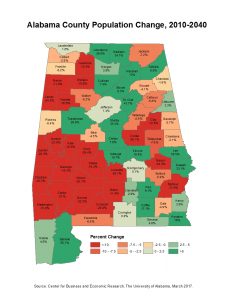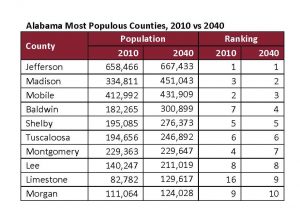 TUSCALOOSA, Ala. — The Alabama population is expected to grow by nearly 500,000 people by 2040, according to the latest projections from the Center for Business and Economic Research in The University of Alabama’s Culverhouse College of Commerce.
TUSCALOOSA, Ala. — The Alabama population is expected to grow by nearly 500,000 people by 2040, according to the latest projections from the Center for Business and Economic Research in The University of Alabama’s Culverhouse College of Commerce.
Expected economic development in major Alabama metropolitan areas and population trends mostly are fueling the projected 11.3 percent increase.
The state population is expected to grow at 3-4 percent per decade, similar to the rate seen in 1980s. This is slower than the 10.1 percent or 7.5 percent growth during the 1990s and 2000s, respectively.
“Declining births and net migration, as well as aging baby boomers, are causing population to grow slower,” said Viktoria Riiman, socioeconomic analyst for CBER.
The growth during the 2010-2040 time period is expected to be half the growth rate seen during the previous 30-year cycle, from 1980 to 2010, Riiman said.
 Jefferson, Madison and Mobile counties are expected to remain the top three most populous counties in the state. Baldwin County is expected to increase in ranking from seventh place in 2010 to fourth in 2040, following a continued unprecedented growth in the Daphne-Fairhope-Foley metro area.
Jefferson, Madison and Mobile counties are expected to remain the top three most populous counties in the state. Baldwin County is expected to increase in ranking from seventh place in 2010 to fourth in 2040, following a continued unprecedented growth in the Daphne-Fairhope-Foley metro area.
The Huntsville metro area is another region that expects a significant population growth. Limestone County is forecast to jump from 16th to ninth place, and Madison would become the second-most populous county, up from third place.
Shelby County in the Birmingham-Hoover metro area is among the top five fastest- growing counties (i.e. with largest percent increase). The county is also among the top five with the largest increase in residents. The ranking of Shelby County would remain unchanged from 2010 to 2040 after more than 81,200 new residents would cause a 41.7 percent increase in population.
The two counties with the largest universities in Alabama are forecast to be among the top five counties with largest population increase. Lee County, home to Auburn University, is expected to add almost 70,800 new residents, while Tuscaloosa County, home to The University of Alabama, is expected to add more than 52,200 people from 2010 to 2040. Growing student enrollment and university expansions are among the major factors influencing population growth in these counties.
Although most Alabama counties in metro areas are expected to gain more residents, most non-metro area counties will see a decline in population. Riiman noted that areas with faster-recovering economies, solid employment forecasts and the highest or most improved quality of life are the ones that are expected to see an increase in population.
CBER forecasts that the population in metro area counties will grow by 16.2 percent from 2010 to 2040. Meanwhile, non-metro area counties will see an overall population decline of 3 percent during this time period. This decline follows a nationwide trend of population losses in counties that are outside large metropolitan areas.
Contact
David Miller, UA Media Relations, 205/348-0825, david.c.miller@ua.edu
Source
Viktoria Riiman, socioeconomic analyst, Center for Business and Economic Research, 205/348-3757, vriiman@cba.ua.edu